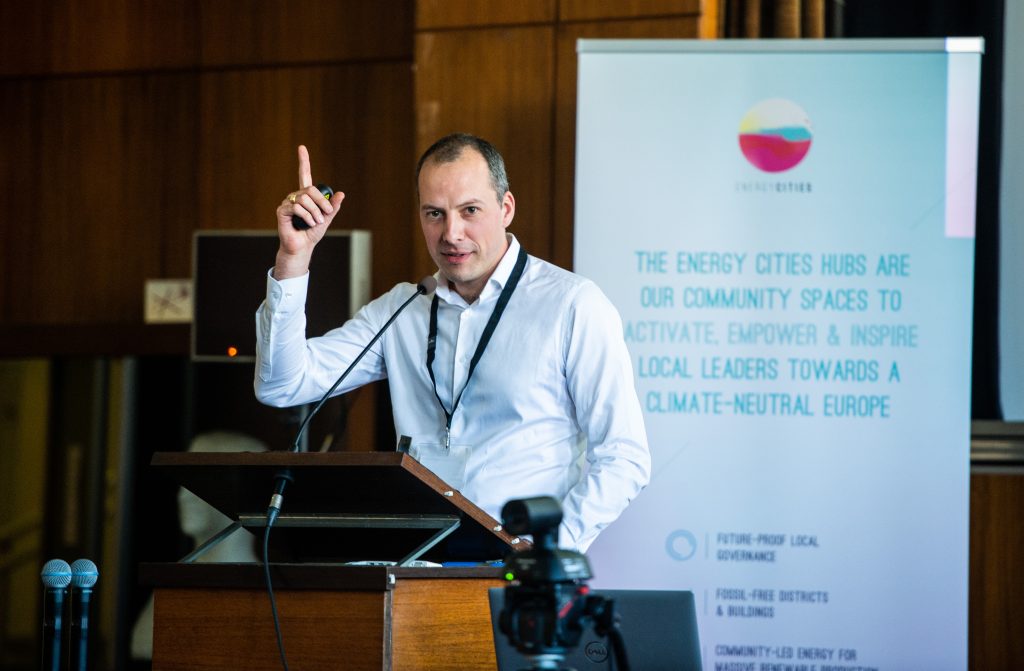“Cities need two things for their buildings: money and legislation!”
Main takeaways from the discussions around the decarbonisation of buildings at the 2022 Energy Cities Forum.
Energy Cities’ Hub “Fossil-free districts and buildings” aims to make cities’ building stock and districts more carbon efficient and sufficient.
Let’s take a look back at the insightful discussions that took place at Energy Cities’ 2022 Forum in Brussels regarding the necessary decarbonisation of buildings!
Many speakers shared their experiences and expertise on this technical question around buildings. The forum was a great opportunity to establish a dialogue between the different levels of political action, as well as with technical experts. First of all, for a better technical understanding of the subject, the IPCC lead author Yamina Saheb presented the SER framework which we have to follow in order to decarbonise our building stock.
The IPCC’s report is clear: decarbonising buildings by 2050 is possible if we include sufficiency, efficiency and renewables in the parc.
Yamina Saheb, Lead author, WG III, Intergovernmental Panel on Climate Change and IPCC AR 6 Lead Author of the Building Chapter




The framework of fossil-free buildings is clear: S for Sufficiency, E for Efficiency and R for Renewables.
Sufficiency is, according to the IPCC’s definition, “a set of policy measures and daily practices that avoid demand for energy, materials, land and water, while delivering human wellbeing for all within planetary boundaries”. Sufficiency is a really powerful lever for lowering GHG emissions not only in buildings, but also more generally. It relies on a systemic change in our lifestyles and in the way we consume and use energy.
Efficiency points to improving the energy intensity of buildings, which means using less energy at the same floor area in a building. This is achieved by retrofitting existing buildings, building low carbon new ones or by replacing fossil-fuel based heating and cooling systems.
Finally, Renewables refer to renewable energies, the proportion of which must increase in the energy consumption of buildings, in view of their low carbon footprint.
This SER Framework must guide the climate and political action in the field of buildings. Now that this framework has been presented, we must see how it translates on the ground.
Only 40% of our houses had basic efficiency measures, we have to offer a quick and effective solution to these households!
Tine Heyse, Deputy Mayor, City of Ghent (Belgium)




Local actors such as energy agencies, municipalities and local governments elaborate a range of different policies in order to achieve fossil-free buildings. For example, the city of Ghent in Belgium set up an “Energie Centraal” which is a local energy agency dedicated to decarbonising buildings. They help citizens improve their energy efficiency by giving them technical support, accompanying them in the design of their retrofitting plan, offering them low interest rates for energy loans, and even suggesting the best businesses to take care of the renovation. Centralising activities so that citizens only have one place to go is a good way of boosting the incentive for them to refurbish their home, making it less expensive and complicated. Another solution brought by the French city of Dijon is the priority given to refurbishments. Since renovations are a long process, Dijon tries to focus on its low-income buildings from the 1970s, in order to protect the most exposed to energy poverty, while gaining a lot more in carbon-efficiency than if they were to refurbish newer buildings.
“Cities needs two things for their buildings: money and legislation!”
Karlis Goldstein, Cabinet member for Energy Commissioner Simson
On the European level, two things are needed to achieve fossil-free buildings. The first is funding. Refurbishing old buildings is expensive, especially in European cities where a lot of buildings are listed. Massive investments would be more efficient if done on a wider scale than on just the national scale – in addition to the fact that not every country would implement the same policy evenly. In order to have efficient funding, speakers pointed out that we need to industrialise the renovation, to achieve a big economy of scale.
Moreover, the second need is that of legislation; necessary to enforce the obligation of renovating, especially on the level of the private sector. There are some laws in place in a few EU countries that already impose this type of measure but again, the EU legislative firepower is necessary to achieve a uniform action and ultimately, fossil-free buildings.
